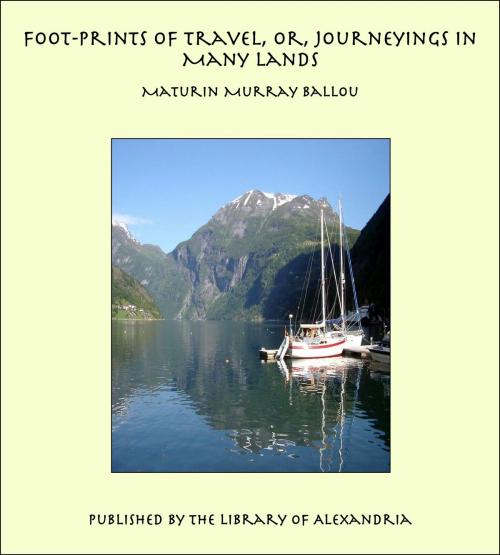Foot-prints of Travel, or, Journeyings in Many Lands
Nonfiction, Religion & Spirituality, New Age, History, Fiction & Literature| Author: | Maturin Murray Ballou | ISBN: | 9781465548788 |
| Publisher: | Library of Alexandria | Publication: | March 8, 2015 |
| Imprint: | Language: | English |
| Author: | Maturin Murray Ballou |
| ISBN: | 9781465548788 |
| Publisher: | Library of Alexandria |
| Publication: | March 8, 2015 |
| Imprint: | |
| Language: | English |
The title of the book in hand is sufficiently expressive of its purpose. We shall follow the course of the sun, but diverge wherever the peculiarities of different countries prove attractive. As the author will conduct his readers only among scenes and over routes which he himself has travelled, it is hoped that he may be able to impart a portion of the enjoyment experienced, and the knowledge gained in many foreign lands and on many distant seas. Starting from the city of Boston by railway, we pass at express speed through the length of Massachusetts from east to west, until we arrive at Hoosac, where the famous tunnel of that name is situated. This remarkable excavation, five miles in length, was cut through the solid rock of Hoosac Mountain to facilitate transportation between Boston and the West, at a cost of twenty years of labor and sixteen millions of dollars; a sum, which, were it divided, would amount to over five dollars per head for every man, woman, and child in the State. By a continuous day's journey from Boston, we reach Niagara late at night. The best view of the falls, which form the grandest cataract on the globe, is to be enjoyed from the Canada side of the Niagara River. In the midst of the falls is Goat Island, dividing them into two unequal parts, one of which forms the American, and the other the Horse Shoe Fall, so called from its shape, which is on the Canada side. As we gaze upon this remarkable exhibition of natural force, a column of vapor rises two hundred feet above the avalanche of waters, white as snow where it is absorbed into the skies, the base being wreathed with perpetual rainbows. A canal, starting from a convenient point above the falls and extending to a point below the rapids, utilizes for mill purposes an infinitesimal portion of the enormous power which is running to waste, night and day, just as it has been doing for hundreds of years. It is well known that many centuries ago these falls were six miles nearer to Lake Ontario than they now are, making it evident that a steady wearing away of the rock and soil is all the time progressing. The inference seems to be plain enough. After the lapse of ages these mammoth falls may have receded so far as to open with one terrific plunge the eastern end of Lake Erie. Long before the Falls are reached we hear the mighty roar which made the Indians call the cataract Niagara, or "the thunder of the waters." On leaving here, we cross the river by a suspension bridge, which, from a short distance, looks like a mere spider's web. Over this the cars move slowly, affording a superb view of the Falls and of the awful chasm below. But let us not dwell too long upon so familiar a theme. After a day and night in the cars, travelling westward, Chicago, the capital of Illinois, is reached. About sixty years ago a scattered tribe of the Pottawatomies inhabited the spot on the shore of Lake Michigan, where is now situated the most important capital of the North Western States. In 1837 the city was formed with less than five thousand inhabitants; at this writing it has nearly a million. Such rapid growth has no parallel in America or elsewhere. This commercial increase is the natural result of its situation at the head of the great chain of lakes. In size it is a little over seven miles in length by five in width, giving it an area of about forty square miles. The city is now the centre of a railroad system embracing fifteen important trunk lines, forming the largest grain, lumber, and livestock market in the world. One hundred and sixty million bushels of grain have passed through its elevators in a twelvemonth
The title of the book in hand is sufficiently expressive of its purpose. We shall follow the course of the sun, but diverge wherever the peculiarities of different countries prove attractive. As the author will conduct his readers only among scenes and over routes which he himself has travelled, it is hoped that he may be able to impart a portion of the enjoyment experienced, and the knowledge gained in many foreign lands and on many distant seas. Starting from the city of Boston by railway, we pass at express speed through the length of Massachusetts from east to west, until we arrive at Hoosac, where the famous tunnel of that name is situated. This remarkable excavation, five miles in length, was cut through the solid rock of Hoosac Mountain to facilitate transportation between Boston and the West, at a cost of twenty years of labor and sixteen millions of dollars; a sum, which, were it divided, would amount to over five dollars per head for every man, woman, and child in the State. By a continuous day's journey from Boston, we reach Niagara late at night. The best view of the falls, which form the grandest cataract on the globe, is to be enjoyed from the Canada side of the Niagara River. In the midst of the falls is Goat Island, dividing them into two unequal parts, one of which forms the American, and the other the Horse Shoe Fall, so called from its shape, which is on the Canada side. As we gaze upon this remarkable exhibition of natural force, a column of vapor rises two hundred feet above the avalanche of waters, white as snow where it is absorbed into the skies, the base being wreathed with perpetual rainbows. A canal, starting from a convenient point above the falls and extending to a point below the rapids, utilizes for mill purposes an infinitesimal portion of the enormous power which is running to waste, night and day, just as it has been doing for hundreds of years. It is well known that many centuries ago these falls were six miles nearer to Lake Ontario than they now are, making it evident that a steady wearing away of the rock and soil is all the time progressing. The inference seems to be plain enough. After the lapse of ages these mammoth falls may have receded so far as to open with one terrific plunge the eastern end of Lake Erie. Long before the Falls are reached we hear the mighty roar which made the Indians call the cataract Niagara, or "the thunder of the waters." On leaving here, we cross the river by a suspension bridge, which, from a short distance, looks like a mere spider's web. Over this the cars move slowly, affording a superb view of the Falls and of the awful chasm below. But let us not dwell too long upon so familiar a theme. After a day and night in the cars, travelling westward, Chicago, the capital of Illinois, is reached. About sixty years ago a scattered tribe of the Pottawatomies inhabited the spot on the shore of Lake Michigan, where is now situated the most important capital of the North Western States. In 1837 the city was formed with less than five thousand inhabitants; at this writing it has nearly a million. Such rapid growth has no parallel in America or elsewhere. This commercial increase is the natural result of its situation at the head of the great chain of lakes. In size it is a little over seven miles in length by five in width, giving it an area of about forty square miles. The city is now the centre of a railroad system embracing fifteen important trunk lines, forming the largest grain, lumber, and livestock market in the world. One hundred and sixty million bushels of grain have passed through its elevators in a twelvemonth















